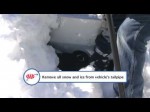LOS ANGELES — Engelbert Humperdink has one. Clint Eastwood does not. John, George and Ringo – yes. Paul McCartney? Not yet. And George Clooney would be in the club if only someone could convince him to show up for the ceremony. When it comes to receiving a star on the Hollywood Walk of Fame, the sidewalk tourist attraction that encompasses 15 blocks of Hollywood Boulevard and three blocks of intersecting Vine Street, it’s not so much who you know, but whether you’re willing to play by the rules. For starters, someone in the celebrity’s camp must first fill out an application form that includes the star’s signed promise that they will attend the ceremony. No pledge? No ceremony. Which is why Eastwood, Julia Roberts and Clooney aren’t among the 2,450 honorees lining Hollywood’s sidewalks. A five-member committee meets annually in June to consider some 250 to 300 applicants from five categories of the entertainment industry – film, television, music, broadcast radio and theater, a category added in 1984. As you might imagine, some of the candidates possess light resumes. Others wouldn’t be able to show up for obvious reasons. “We’ve had applications from Santa Claus and the duck that represents an insurance company on commercials,” says Walk of Fame producer Ana Martinez, who attends the voting meeting and decides where the stars are eventually placed on the street. “Somebody insisted Shakespeare should have a star,” Martinez adds. Typically, the Walk’s committee annually selects 20 to 24 new honorees, who must then pay a $30,000 sponsorship fee. This covers the cost of constructing the three-foot-wide stars as well as the cost of the ceremony. A portion of this money also goes to the Walk’s trust fund for continued maintenance. Of course, the honorees themselves rarely foot the bill. Recipients have five years to schedule their ceremony. Most celebrities time the event to coincide with a promotional opportunity. “Stars like to make it a big deal,” Hollywood Chamber of Commerce president Leron Gubler says. “That’s the way they are. They get a little more bang for their buck out of it when they time it right.” Thus, September’s star recipients Neil Patrick Harris and Jon Cryer scheduled their ceremonies to coincide with the fall premieres of their long-running television series, “How I Met Your Mother” and “Two and a Half Men,” respectively. The shows’ production companies each paid the $30,000 fee. Rock star Melissa Etheridge, a recent honoree, saw her star unveiled in front of the Hard Rock Café, which, not coincidentally, paid her bill. Etheridge used the ceremony both to thank her fans and launch Hard Rock’s Pinktober breast cancer awareness campaign. Etheridge, 50, was diagnosed with breast cancer in 2004 and has been a spokesperson for the event for the past six years. “It’s forever,” Etheridge says of her star, following a morning ceremony attended by an estimated 500 people, including many fans who traveled on their own dime from across the country to be at the event. “We’ve been playing this fame game for 100 years here in this city of dreams,” Etheridge adds, noting she came to the Walk of Fame when she visited Los Angeles as a teenager. At 51, the Walk of Fame is roughly half of Hollywood’s age, and many of its stars are in need of a little cosmetic surgery. Tree roots along Vine Street have caused the stars’ black and pink terrazzo concrete to crumble. Heat and foot traffic are factors, too, contributing to the buckling of the stars’ brass name lettering, borders and emblems. The Hollywood Chamber of Commerce initiated a restoration project in 2008, grading each of the walk’s stars. Nearly 800 were targeted to be repaired or replaced. Raising the $4.2 million needed to complete the project hasn’t been easy. Corporate sponsors have donated about half the total, to go along with money from private donors and a portion of the proceeds from the star ceremonies. Though still short of the goal, Gruber says he hopes work can begin next year. “We don’t have the money to do the whole walk,” Gruber says. “We’ll start with the worst sections and go from there.” Redevelopment, including the Hollywood and Highland complex and its Kodak Theatre, the permanent home of the Academy Awards, have bolstered the fortunes of the walk’s west end in the past decade. The Walk of Fame, along with the famous movie star footprints at Grauman’s Chinese Theatre, remain popular attractions for tourists visiting Los Angeles. “They’re iconic places that still resonate with people, though what’s in the imagination probably doesn’t align with the reality,” says USC professor Leo Braudy, whose book “The Hollywood Sign” covers another area landmark. “It’s a way for people to connect with their favorite celebrities,” Braudy continues, “though if you really want to meet one, you’d have a lot more luck going to the nearest supermarket.” ? Read more from the original source: Why Doesn’t George Clooney Have A Star On The Walk Of Fame?





